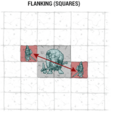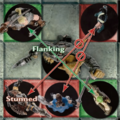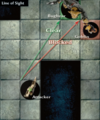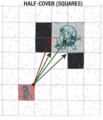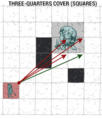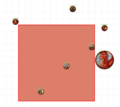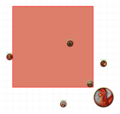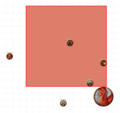Waterdeep:House rules: Difference between revisions
m →Rulings |
mNo edit summary |
||
| Line 56: | Line 56: | ||
The Roll20 campaign has dynamic lighting enabled. This unfortunately only operates using actual circles. I will attempt to operate as though lit areas are square as well, although in some cases it may be a guess/judgement call. | The Roll20 campaign has dynamic lighting enabled. This unfortunately only operates using actual circles. I will attempt to operate as though lit areas are square as well, although in some cases it may be a guess/judgement call. | ||
=== Ball bearings === | === Ball bearings === | ||
Revision as of 08:07, 23 May 2023
This page is protected, and may only be edited by Waterdeep GMs. |
This page lists house rules for the Waterdeep campaign, and rulings that have been made during play.
House rules
Flanking
Flanking will be available to players and monsters in this campaign. However, instead of advantage as per the optional flanking rule listed in the DMG, flanking will give +2 to attack rolls. This allows for tactical movement, without invalidating race or class features such as Pack Tactics and Reckless Attack.
You have flanking if you are within 5ft of your target, there is a creature who is an enemy of your target (not necessarily your ally) which is not Incapacitated
and which is also within 5ft of your target, and the line between the center points of your occupied space and the other creature's occupied space crosses opposite sides of the target's occupied space, or opposite corners of the target's occupied space.
-
Two characters on opposite sides of a large enemy
-
The stunned character cannot provide flanking, because they are incapacitated
-
The line passing between the top edge and right edge does not result in flanking
Line of sight and cover
In order to have line of sight on a target, you must be able to trace a line from any corner of your occupied space to any corner of any square of the target's occupied space, without crossing into a square of blocking terrain. Creatures in your path do not block line of sight.
-
The red line has to pass through the wall to reach the goblin
To determine cover from a ranged attack or Dex save effect, select any one corner of a square that you occupy and trace four lines from it to the four corners of one square in the target's occupied space. If one or two of the lines cross into blocking terrain or a space occupied by an enemy creature, the target has half cover (+2 AC and Dex saves). If three of the lines cross into blocking terrain, the target has three quarters cover (+5 AC and Dex saves). Creatures cannot result in three quarters cover, only half cover.
Cover from melee attacks and area effects work similarly to ranged attacks, except that creatures cannot provide cover against them.
-
Only one line is blocked by a wall, so the creature has half cover
-
Three lines are blocked by a wall, so the creature has three quarters cover
-
One line to the goblin is blocked by a wall (half cover), and one line to the troll is blocked by the goblin (half cover), while the ally does not provide cover to the bugbear
-
Cover from area effects is measured from the origin point of the area, and no creature provides cover from it
Resting
Short rests take 10 minutes, instead of 1 hour. You may only take 1 + (proficiency bonus / 2) short rests per long rest. This means that at level 1-8, you can take 2 short rests per long rest. At level 9-16, you can take 3 short rests per long rest. At level 17-20, you can take 4 short rests per long rest. Spells and features which give the benefits of a short rest (eg, catnap or a Genie Warlock's Sanctuary Vessel) do not count against the limited number of short rests per long rest.
Monks must spend 5 minutes meditating during a short rest in order to regain ki points, instead of 30 minutes.
During extended travel only, short rests require 1 day and long rests require 7 days.
Inspiration
At the start of each game session, you will gain inspiration. Inspiration functions as normal: spend your inspiration to gain advantage on an attack, saving throw, or ability check, or else to give inspiration to another player. Using inspiration to gain advantage on a roll must be done before you make the roll. Using inspiration to give another player inspiration must be done before they can spend it (and therefore before they make the roll they would spend it on), however spending inspiration is not an action so it doesn't have to be on your turn or use an action or reaction, and can be spent even if you're incapacitated. As per standard inspiration rules, a player can only have one inspiration at a time (so if you don't spend your inspiration by the end of the session, you won't get a second one next session).
Rulings
Distance and square Fireballs
We will use default distance measurement rules (that is, diagonals do not require additional movement). A consequence of this, which is often overlooked, is that effects which would be described as circles or spheres are measured out to be squares or cubes. This is a slight buff to many area effects, but while it means more enemies could potentially be caught by your fireball, it could also catch allies which would not have been hit using an actual sphere.
Similarly, a cone effect such as cone of cold or a cone-shaped breath weapon will be a square of appropriate size, with at least one corner of any square on the edge of the area touching a corner of any square on the edge of the source's occupied space.
-
The breath weapon touches the dragon's occupied space
-
Cones can touch the source creature's space at the corner
-
Any side works equally well
The Roll20 campaign has dynamic lighting enabled. This unfortunately only operates using actual circles. I will attempt to operate as though lit areas are square as well, although in some cases it may be a guess/judgement call.
Ball bearings
You may use your action to dump out up to' 1,000 ball bearings, instead of exactly 1,000. Every 250 bearings you dump out covers one 5x5 ft. square on the map. Those squares must be contiguous, but in any chape. So as a single action you could cover a 5x5 ft. square (using 250 bearings), a 10x5 ft. rectange (using 500 bearings), a 10x10 ft. L-shape or 15x5 ft. line (using 750 bearings), or a 10x10 ft. square, 10x15 ft. L-shape, 10x15 ft. Z-shape, or 20x5 ft. line (using 1,000 bearings).
Dragging grappled creatures
The rules as written for dragging grappled creatures doesn't make clear exactly where the drag-ee moves in relation to the drag-er. In this campaign, dragging a creature functions thusly: you move 5 ft., and then you may have the creature you're grappling move 5 ft. to occupy the space that you just vacated. (Repeat for as far as you are willing and able to drag them.) If you are grappling multiple creatures, one creature occupies the space you vacated, and you may have each other creature move to a space of your choice that is both within 5 ft. of the first creature and within 5 ft. of you. If there is no such space for the additional creature to move to, that creature is released from the grapple and doesn't move.
Creatures with greater than 5 ft. reach who drag grappled creatures work similarly, save that the drag-ee(s) can be further away from the drag-er.
